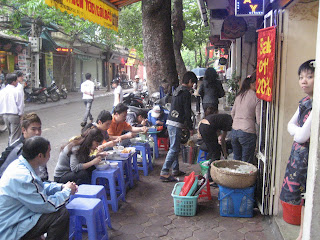This photo is pretty typical of the sidewalks of Saigon. They are crowded, chaotic, torn up, obstructed, and messy. They are also orderly, organized, and surprisingly clean. Like a lot of other things in Saigon they are paradoxical. For an outsider they take a little getting used to.
I like to learn a city by walking it, but it’s close to impossible to do here. Except for Dong Khoi, the main shopping street in the tourist center, there are almost no walking streets in Saigon – and for practical reasons almost no one walks anyway. It’s hot. It’s humid. And, except for Sunday, there is almost never enough room to negotiate the narrow spaces between storefronts and the streets.
My view of sidewalks was formed in urban America where they are pedestrian zones that provide a safe path, off the street, for strolling, exercise, or neighborhood shopping. In Saigon they are extensions of the streets, restaurants, living rooms, showrooms, bedrooms, parking lots or playing fields. At any time of the day or night they are teeming with activity. At 3:30AM families are setting up their food stands or sidewalk retail operations. As the day emerges they expand into motorbike parking lots, alternative motorbike roadways, communal living rooms, cottage industries, social centers, and classrooms of this energetic country.
If I had seen the future I would have invested in children’s furniture 15 years ago. Every Vietnamese sidewalk is crowded with the tiny tables and chairs that characterize the entrepreneurial spirit and energy of this city of 8 million. At first I thought they were comical, but they are just another practical solution to the space problem – and they are surprisingly comfortable.
The sidewalks of Saigon are an interesting challenge for Westerners but they are also the business hubs and venture projects of an emerging economy that cannot be contained by its architecture. So, grab a tiny chair, order a ca phe sua da (Vietnames iced coffee), and enjoy the show. This is where it’s all happening.
































